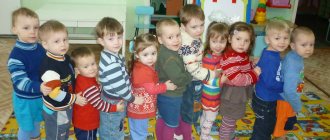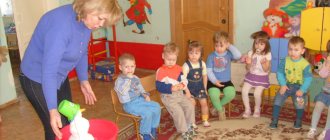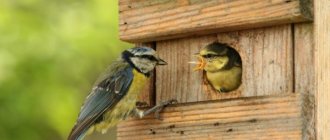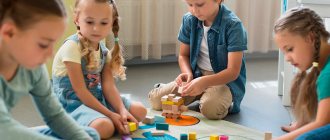Goals and objectives of conducting outdoor games with children
For the children of the second junior group, it is very important that the fun used in classes and at leisure be mobile to varying degrees. Only in this case, gaming activity allows you to achieve your goals, namely:
- promotes the comprehensive development of pupils (physical, emotional and volitional);
- improves health (musculoskeletal, cardiovascular, respiratory systems);
- develops the skill to follow the terms of the game;
- stimulates the desire to interact with adults and children;
- fosters the need to feel part of a team.
To achieve these goals during the game, it is necessary to systematically and consistently solve problems such as:
- mastering the skill of performing motor exercises of varying degrees of complexity together with friends and/or a teacher;
- practicing the skills learned last year to run, walk at different speeds, throw and catch a ball, long and high jump;
In the second younger group, games play an educational role, in particular they instill a sense of camaraderie
- improving the skill of giving movements characteristic features through imitation (for example, flapping their wings like a bird, moving smoothly like a cat, etc.);
- continuation of work on exercises for orientation in space, performing actions according to the conventional sign given to the driver;
- learning to coordinate your actions with the course of the plot and the conditions of the fun, as well as to correlate your movements with the movements of your comrades;
- encouraging initiative.
"Hunters and Foxes"
The court, no larger than a basketball court, is limited by lines. The players choose a driver - the “hunter”, and they give him a small ball. All other players are “foxes”.
- The “Hunter” goes to the middle of the site, and the “Foxes” gather around him. The “hunter” throws the ball up twice and catches it; after the third throw, the “foxes” scatter in different directions.
- The “hunter”, having caught the ball, throws it at one of the “foxes”. Each “fox” that is born becomes his assistant, which means that the number of “foxes” will decrease.
- As soon as the “hunter” has a first assistant, the “foxes” can pick up the ball thrown at them and throw them among themselves so that the “hunter” and the assistant do not take possession of it. Now the drivers are trying to intercept the ball in order to kill the “foxes”.
- The game continues until all the “foxes” are caught, except one. This “fox”, who has proven herself to be the most dexterous, becomes the new “hunter”.
- The game repeats itself.
During the game, it is important to ensure that the “foxes” do not run beyond the boundaries of the court. Otherwise, each of them is considered salted and becomes an assistant to the “hunter”. Before the start of the game, you can agree that you can’t shoot, for example, in the head, fod, etc.
Sources:
- https://inteltoys.ru/articles/cat4/article534.html
- https://parentchild.ru/472520a-igryi-s-myachom-dlya-detey-nazvaniya-i-pravila
- https://www.maam.ru/detskijsad/kartoteka-igr-s-mjachom-dlja-detei-6-7-let.html
- https://www.idealdomik.ru/yenciklopedija-poleznyh-sovetov/deti-i-roditeli/podvizhnye-igry-s-mjachom-dlja-detei-7-8-9-let.html
Types of outdoor games
Fun of an active nature is classified according to the main problem they are aimed at solving.
- To practice running and jumping. By the age of 3–4 years, it is important for children to develop the ability to coordinate their movements and maintain their direction.
- Orientation in the room, gym, on the playground.
- To train the ability to maintain balance (usually in games of moving around a small area, accompanied by poems).
- To strengthen the muscles of the musculoskeletal system.
- For imitation.
- To practice climbing skills.
- With a ball. Such games also form partnerships between children.
- To develop sharpness of attention.
Another classification of fun is based on the types of educational activities:
- physical education breaks, which are held during classes for relaxation or change of activity;
- games during organized leisure time on the street;
- part of leisure activity (games outside of class, that is, on holidays, during independent activity);
Outdoor games are part of the scenario for matinees and holidays
- folk traditional games (such fun is also carried out with the aim of familiarizing children with the customs of their people).
Thus, the type classification of games allows for fun not only during physical education breaks in classes, but also as a fundamental element in:
- physical education;
- music lesson;
- choreography (provided that the discipline is included in the kindergarten curriculum).
"Edible, inedible"
During the game, concentration of attention, the ability to focus on a separate object, and reaction speed develop. In a short time, children learn to divide objects into two groups - edible and inedible. The rules can be used for playing with a ball at home for two.
The gameplay is as follows: A ball is thrown to the child and words are called - nouns. He must catch those throws that are accompanied by words denoting edibles, and discard all others.
Another version of this ball game involves rolling it from one player to another, naming different categories of words that children need to master (animals, plants, birds, pieces of furniture or wardrobe). By participating in the process, the child learns to quickly remember new names and words.
Techniques
The organization of gaming activities is based on three groups of techniques.
Verbal
In working with children 3–4 years old, who, based on age-related developmental characteristics, are actively mastering speech and replenishing active and passive vocabulary, the teacher’s word plays a leading role. An adult is perceived not only as giving instructions, but also as a kind of language model, which children are guided by in organizing their own acts of speech. When preparing outdoor games, the teacher uses three types of verbal techniques.
- Explanation. In order for the children to accurately follow the rules of the game and know the set of actions, the teacher describes each stage in detail, indicating all the movements of each participant.
The teacher must comment on every action in the game
- Puzzles. This technique perfectly motivates little pupils to play and prepares them to complete tasks. Considering the age of the children, it is better to select riddles with rhyming agreements. Thus, the beginning of the game “Sparrows and the Car” can be preceded by the following riddle: A cry is heard under the eaves: “Chick-chirp and chick-chirp!” The gray one teaches these songs to children... (Sparrow).
- Short verbal sketches. Usually, to present the plot of the game, the teacher himself composes small tales. For example, the fun “Hen and Chicks” can begin with a short sketch. Once upon a time there lived a Hen and she had many chickens. Often they did not listen to their mother and ran out from under her wing. One day, when the kids ran away, Big Bird flew in and chased the chicks. The chickens were scared, but managed to hide under the wings of their mother hen. From now on, the kids are very attentive and do not run far.
Visual
The visual channel of perception in children is the main one, therefore, to fully understand the conditions of the game, children need to see:
- pictures (depicting game heroes and/or children fulfilling the conditions of the fun);
- a sample of actions (an adult must participate in any games, initially demonstrating the movements of all participants).
The demonstration helps children make sure that the adult is a participant in the game just like them.
Practical
This is actually the game situation itself, in which children and the teacher are involved. Moreover, to develop initiative, after 2-3 repetitions, the teacher gives more and more game functions to the children: if, when familiarizing themselves with the rules, the teacher is the driver, then the child then takes on this role.
Rules for organizing outdoor fun in the second junior group
- Outdoor games with children in preschool educational institutions are held every day.
Outdoor games are held at any time of the year
- In duration, one fun lasts no longer than 10 minutes.
- In one session, no more than 2 games can be played in the second junior group. It is important to take into account that they should have different degrees of mobility: for example, one is more active with running and jumping, and the second is calm, with walking.
- If games are played in a group, then the room must be thoroughly ventilated and the floors wiped before starting work.
- To create a situation of success, it is very important to give every child the opportunity to express themselves. Therefore, games are held either for all the children in the group at the same time, or for small groups of interests.
- Outdoor games are played immediately after exiting.
- If the child refuses to participate, the teacher should not insist. However, it is necessary to find out the reason for this behavior. Perhaps the child has a fear of getting hurt. In such situations, therapeutic fairy tales or cartoons will help.
- Games must be selected taking into account the types of activities in which children were previously involved. So, if the game is planned after physical education or choreography, then it should be calm, but after sleep, mobility may be different.
- It is very important to help the child at each stage of the game. Therefore, the teacher, remaining in the position of a leader, directs and shows the children all the movements: how to catch a ball, how to spin a hoop, etc.
- The plot of the game must be built around a familiar and understandable image, represented by a picture or a toy.
- The game should not have complex movements; you need to select only those that are understandable to children 3–4 years old (catch up with the ball, bring the pins, ring the bell, etc.).
- The fun should include not only new, but also well-known movements for the children. For example, in the game “Shaggy Dog,” when kids run away from the dog, it is worth designating a small area of the area for running in one direction so that the players can repeat the already mastered skill of directional running.
- Before the game starts, the teacher introduces the children to the rules and pays attention to the signals by which the kids will need to change their method of movement (from running to walking, from walking to climbing, etc.). In addition, the teacher shows all the attributes that will be needed in the fun (balls, hoops, etc.).
- When helping children, showing movements and actions, the adult uses gestures and facial expressions.
- The success of the game depends on how carefully the teacher thinks through and takes into account all the details: designating places for “houses”, “nests”, etc.
If the game is played outdoors, then the teacher needs to make sure in advance that there is enough space for everyone
- One game needs to be repeated for 2-3 days, after which you need to learn a new one and again turn to the already familiar one.
- When distributing game tasks, the teacher takes into account the mobility and temperament of each child and combines and changes their roles. At the same time, you should not give a melancholic person the task of running with acceleration, even if he has not yet performed in this role. Just as you shouldn’t miss the moment when it’s time for a choleric person to run, and not just catch a ball.
- Everything good should not be harmful. Therefore, it is important not to let children become overtired: paleness, sweating and distracted attention are signals that it is time to stop playing.
- To create a positive microclimate, the teacher must be friendly, cheerful and at the same time maintain objectivity.
Card index of outdoor games for the development of various skills
If didactic games are conducted according to the principle of compliance with the lexical topic, then outdoor fun is grouped by:
- physical skill being practiced;
- the totality of implementation of the assigned tasks in one complex;
- topic (the principle is similar for didactic games).
In this case, it is necessary to take into account the fact that the last principle is the least productive, since the plots of outdoor games can easily be transformed from one lexical topic to another. For example, the fun “Hen and Chicks” when working with the topic “Pets” can easily become “Penguin and the Little Penguins” when working with the topic “Animals of the North”.
On the street, you should try to choose games in which it is possible to beat the objects of the sports ground
The most convenient and universal classification is based on the principle of the skill being practiced.
Running, jumping
- "Aircraft". With the help of this game, children practice running in different directions without colliding with partners, learn to listen carefully to instructions, and also quickly react to a signal to change the nature of the movement. Conditions: the teacher shows movements simulating the readiness of an airplane for flight, starting the engine (rotational movements of the arms in front of you while pronouncing the sound “R-r-r”), flight (running with arms spread to the sides) and “landing” for landing (on a bench ). Children repeat the entire complex, listening to the teacher’s instructions.
- "Sun and Rain." The goals of the game are similar to those described in the previous game. Conditions: the teacher marks a line on the playground beyond which children squat. At the signal: “The sun is in the sky, you can go for a walk,” children run around the playground. After the words: “Rain!” urgently return to their places.
In the second younger group, the main element of games is running, jumping is rarely included
Orientation in space
- "Sparrows and a car." This game helps children practice running in different directions, the skill of starting and changing movements at the driver's signal. Conditions: children are “sparrows” who sit on a bench “in a nest”. An adult imitates a car. At the words: “Fly, sparrows,” the kids run away, and at the signal: “The car is moving, everyone fly to the nest!”, they quickly run to their places on the bench.
- “The Bird and the Chicks” (“The Hen and the Chicks”). Goals: coordinate your movements with the words of the driver, learn to run in all directions without catching each other. Conditions: the driver appoints himself a “bird”, gathers the “chicks” - all the guys - around him within the boundaries of a drawn circle. At a signal, the kids run away from the circle and return back at the same signal. As a variant of the same game actions, you can play the game “Find your house” or “Birdhouses”. The conditions of the latter are a little more complicated: all children are appointed starlings, but nests are drawn for only half of the participants, so whoever did not manage to take their place at the signal is considered a loser.
- "Shaggy Dog." To the goals already identified in previous games of this group, one more is added: not to get caught by the catcher. Conditions: on one side of the site there is a “dog”, on the other there are children sneaking towards him. The teacher illustrates this movement by saying that the dog is lying quietly, but what will happen if you wake it up. And then the “dog” wakes up and starts barking. The children return to their seats, and the dog tries to grab them along the way. Anyone who fails to escape becomes a dog.
Outdoor games can be supplemented with elementary costumes or masks
Developing a sense of balance
- “I’m holding a handkerchief.” Goals: to train balance and practice the skill of performing movements on a signal. Conditions: kids place a scarf on their hand (or other part of the body) and, performing different movements, hold it in its original position.
- "We're parking the car." Goal: practice walking forward with your back. The teacher invites all children to become cars that need to be parked. To do this, each child, following the driver’s instructions regarding the direction of movement (“left”, “right”, “turn”), parks the “car”.
Imitation skill
- "Bubble". The game encourages children to act in accordance with the words of the plot, teaches them to coordinate their movements with the movements of other participants, develops imitation skills and encourages children’s initiative. Conditions: the teacher and children, holding hands, make a circle. Then the leader says 2-3 times: “Inflate, bubble, but don’t burst,” the round dance participants disperse wider and wider, and in response to the words: “The bubble has burst!” children open their hands, pronouncing the sound: “Sh-sh-sh.”
- "Vaska the cat." The goals of this game are identical to the previous one. A child cat walks around the playground, purring. Kittens are playing around nearby. And so Vaska falls asleep, the kids run to him, accidentally wake him up, and then run off to their “houses” - their chairs.
- "Legs." The purpose of this game is to practice the skill of repeating the actions of the instigator. Conditions: the teacher demonstrates running in place at different paces, the children repeat, and then says: “In the hole - bang,” and the children long jump.
Imitation games, due to their simple plot and simplicity of movements, can be used as physical education
Agility development
"Rabbits." Goals: practice jumping forward on two legs, practice the skill of climbing under a stretched rope barrier. Conditions: the kids are located in a “cage” - behind a rope stretched at a height of 40–50 cm from the floor. After the driver says: “Jump onto the lawn,” the children crawl under the barrier and jump “on the lawn.” At the signal: “Watchman!” they also return back to the “cells”.
Climbing skill
In the second junior group, as in the first, games to practice climbing skills are played at the wall bars. For example, the “Monkeys” game, according to which kids need to climb 3-4 steps up a gymnastics wall.
In the second junior group, climbing skills and agility are also practiced on the obstacle course
Development of attention
- "Leaf fall." The purpose of this game is to teach kids to move to rhyming lines. Conditions: children take autumn leaves from their hands, and to the words of the teacher, wave them in different directions, spin around, squat, and then put the leaves on the ground next to them.
- “Show it right.” Goals: to teach children to listen carefully to the driver, to coordinate movements with words. Conditions: the teacher names the parts of the body that the children should touch, but at the same time the adult himself touches the wrong ones. Children must navigate and point correctly.
- “Who will throw the ball further?” Goal: follow the direction of objects. Children throw balls, remember their location, and then run to them and themselves or with the help of a teacher determine who is a better thrower and who is a worse thrower.
This is interesting. A number of methodologists identify a separate group of games aimed at relaxing children after physical activity. These include, for example, “Find a Bunny” (“Find a Bunny”). The essence of the rules comes down to the fact that the teacher hides a toy - a bunny, and the children, calmly moving around the group, look for it. Some teachers classify such games as mindfulness games.
Natural material, for example, autumn leaves, can be used as an attribute for games.
Neuropsychological ball games
Many games, unfortunately, are becoming a thing of the past, and the games familiar to many adults become “special”, called “neuropsychological”, and are played by children in specialists’ offices.
Why not play these simple and exciting games with your child, which will help avoid many problems in the future. ⠀ Ball games proposed by the famous neuropsychologist A. Semenovich: ⠀ 1. A child and an adult throw a large ball to each other from different distances and catch it with both hands. First, it’s better to throw in your hands, then a little to the right, to the left, higher, lower. Children should be able to throw a ball using both hands from below, from above, through the air or hitting the floor. We must try not to press the ball to ourselves, but to catch it only with our hands. ⠀ 2. The child throws a large ball against the wall in two ways:
1) throws it and immediately catches it; 2) throws it, lets it hit the floor once and only after that catches it. ⠀ 3. An adult and a child sit on the floor at a distance of 2-3 m from each other and take a large ball. They spread their legs and begin to roll the ball across the floor. First, they push him away from themselves with both hands, after a minute or two the child puts his left hand behind his back and rolls the ball only with his right hand, and after 3 minutes - only with his left. The ball should roll smoothly and directly into the hands of a partner. ⠀ 4. The child and adult perform all previous exercises with a medium-sized ball. ⠀ 5. A child and an adult throw a tennis ball to each other and catch it with both hands. ⠀ 6. A child and an adult roll balls on the floor to each other, while simultaneously pointing large and tennis balls towards each other. ⠀ 7. The child throws a large ball against the wall, but with a clap (threw - clapped his hands - caught). ⠀ 8. The child throws a tennis ball from his right hand to his left hand. ⠀ 9. The child throws different balls at a vertical target. The target can be a circle of paper attached to the wall or a hoop in the hand of an adult. ⠀
10. The child throws the ball back without turning, and an adult or another child catches the ball from behind. Players change places one by one. ⠀ 11. An adult and a child throw a tennis ball to a friend and catch it with one hand. ⠀ 12. An adult throws a ball and names the month, and the child catches the ball and says what time of year this month belongs to. ⠀ 13. A child throws a tennis ball against the wall and catches it with one hand. ⠀ 14. A child throws a ball against the wall and, when the ball flies off the wall, jumps over it. ⠀ 15. An adult places a target in front of the child that needs to be shot down. For example, two objects are placed on a stool, and several more objects are placed side by side on the floor. The child moves 8-10 steps away from the stool and tries to knock them down with a ball (large, medium, tennis). ⠀ 16. An adult places a horizontal target (basket, bucket, basin) in front of the child. The child’s task is to hit this target with a ball (large, medium, tennis). ⠀ 17. The child should lean forward and, pushing the ball alternately with the fingers of his right and left hand, roll it around his feet (describing a figure eight - right, left). ⠀ 18. The child throws a tennis ball against the wall and catches it alternately with his right and left hands. ⠀ 19. A stripe is drawn on the floor (or a rope is placed). The child stands at the beginning of this line and moves forward, hitting the ball on the floor either to the right of the line or to the left of it.
Playing with a ball can relieve tension and develop a child’s coordination, thinking, reaction speed, attention, accuracy and endurance.
Sincerely, Olga Naumova
Time plan and game execution
In the second younger group, the game lasts up to 10 minutes and includes working through five stages.
- Introductory stage up to 1 minute. The teacher announces the name of the game, motivates and briefly describes the main actions (“We will run/climb/jump”, etc.).
- Familiarization with the rules. The teacher describes in detail the actions of each participant in the plot (2 minutes).
- Game up to 5 minutes.
- Complicating conditions (1 minute). For example, the teacher relieves himself of his powers as a driver and transfers them to the child. The first 2-3 times this step is skipped.
The complexity of the rules takes into account the characteristics of the group’s level of development, and may even be omitted altogether.
- The final stage (reflection) – 1 minute. The teacher thanks the children for the game, praising their speed, dexterity and desire to help a friend.
Table: example of a summary of the outdoor game “Wolf and Hare” in the second junior group
Author - Krasavina M.K., teacher of MBDOU DSKV No. 17 “Ladushki”, Nizhnevartovsk, Khanty-Mansiysk Autonomous Okrug.
| Stage | Content |
| Introductory | Educator: Guys, look, a bunny came to visit us. He's not happy. Let's ask the bunny what happened? The teacher asks the bunny what happened, why is he sad and cheerless? Educator: Guys, the bunny told me that he has no friends and has no one to play with. Let's make friends with the bunny and play. The bunny loves to play the game “Wolf and Hares.” You and I know this game. Let's remember the rules of the game, what not to do? Children's answers (you can't shout or push while playing) |
| Introduction to the rules | Each bunny will have its own house, this is a chair. Children-hares sit on chairs. There is a wolf to the side. Hares run out into the clearing, jump, nibble grass, and frolic. At the teacher’s signal: “The wolf is coming!” - the hares run away and sit on a chair. The wolf is trying to catch up with them. The game uses the text: Bunnies are jumping: skok, skok, skok, To the green meadow. They pinch the grass, eat it, listen carefully, is a wolf coming? |
| A game | Children perform the actions described in the poem. With the end of the text, a wolf appears and begins to catch hares. Instructions for carrying out. The child playing the role of the wolf should be away from the place where the children are sitting. Then the child, playing the role of a wolf, runs out and catches the children - bunnies. (the game is repeated several times). |
| Complication | We place the wolf closer to the hare children. |
| The final stage | Guys, look, the bunny has become cheerful, he liked playing with you, but it’s time for him to return to his forest. Did you guys like the game? Well done! |
Video: outdoor game “Shaggy Dog” in the second junior group
Video: outdoor game “We stomp our feet”
"Hot Potato" and "Kolobok"
| "Hot potato" | “Kolobok” |
| Purpose of the game: To teach children to catch and throw a ball to a friend at close range. This develops speed, agility and attention. Children stand in a circle and, at the “hot potato” signal, begin tossing the ball to each other. A child who does not catch the projectile must run a circle with it, return to his place and continue the game, throwing it to a friend. | Purpose of the game: To teach children the ability to catch and roll it at close range. The adult is in the center of the circle with a projectile in his hands, he is surrounded by children in a chaotic manner. Then he says: “Kolobok—the ruddy side—rolled into the woods.” Next, the word “hares” is pronounced, and the children begin to jump, imitating these animals. Then the adult says: “The bun is rolling toward the hare,” and says the child’s name. The kid must catch the ball and roll it back. Then the presenter says: “Wolf,” to which the children begin to move. With the words “the bun jumped to the wolf,” the child’s name is pronounced again, and a ball is thrown to him (from bottom to top). The baby must catch and throw it back in the same way. |
How to analyze an outdoor game
Any stage of educational activity in a preschool educational institution is subject to analysis, which is carried out by colleagues, methodologists, and self-analysis, which is compiled by the teacher himself. The first is necessary to assess the level of methodological competence of the teacher, and the second is to identify and correct errors in organizing and conducting outdoor games with children. These analyzes in the context of gaming activity are carried out according to the same algorithm.
The more children are interested in the game, the more successful the analysis of the fun will be.
Parsing scheme
- The hour when gaming activities begin.
- How many children took part?
- Are the goals and objectives appropriate for the age category?
- Who initiated the game? In younger groups, this role is always played by the teacher.
- What motivational techniques were used in the beginning.
- How logically were the rules of the game laid out? And also were there instructions regarding the location of all players and the necessary attributes.
- How clear are the rules for children? In case of violations, describe the reasons.
- Level of preparation of attributes (especially important if they were done manually).
- How were the roles distributed in the game: the teacher appointed or chose the driver and other counting rhymes.
- How ready are the kids to cooperate (do they help each other, are they tolerant of their friends’ mistakes).
- At what level do children develop speed of movement, agility, and endurance?
- How is the role of the teacher assessed in the game (the logic of recommendations during the game activity, how often does it become an observer).
- How is the summing up carried out (does the teacher praise the kids, does he single out those who distinguished themselves).
- How long did the game last and how many times was it repeated?
Outdoor games occupy a special place in the educational work of preschool educational institutions, as they are aimed at achieving goals related to preserving the health and physical development of children. However, conducting games with pupils of the younger group, taking into account their age characteristics, requires the teacher to have thorough knowledge of the methods for preparing this kind of fun. Starting from species classification and ending with the distribution of time between all stages of implementation.






